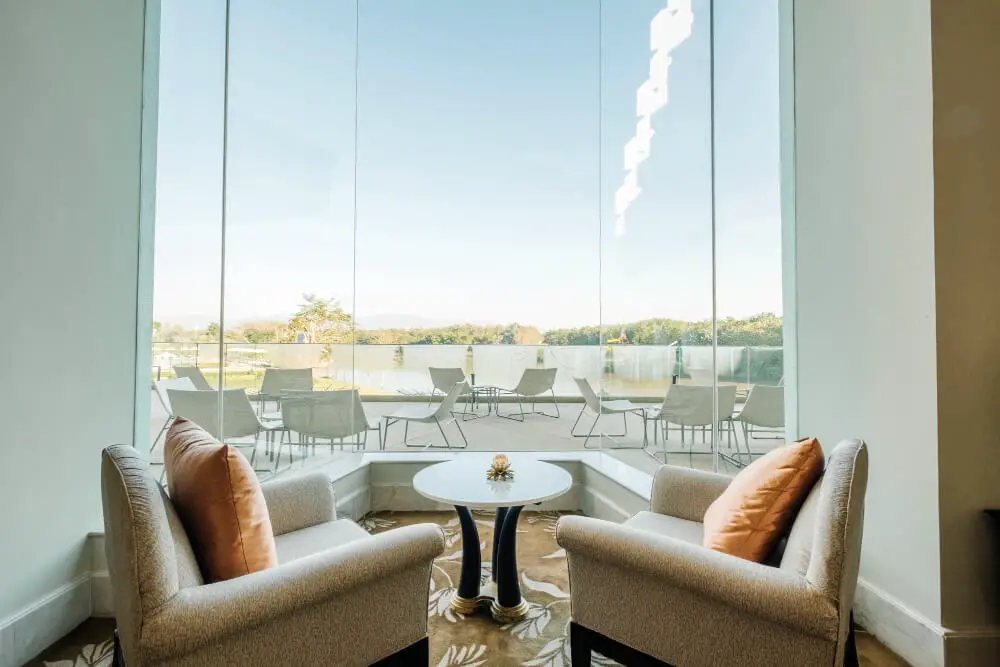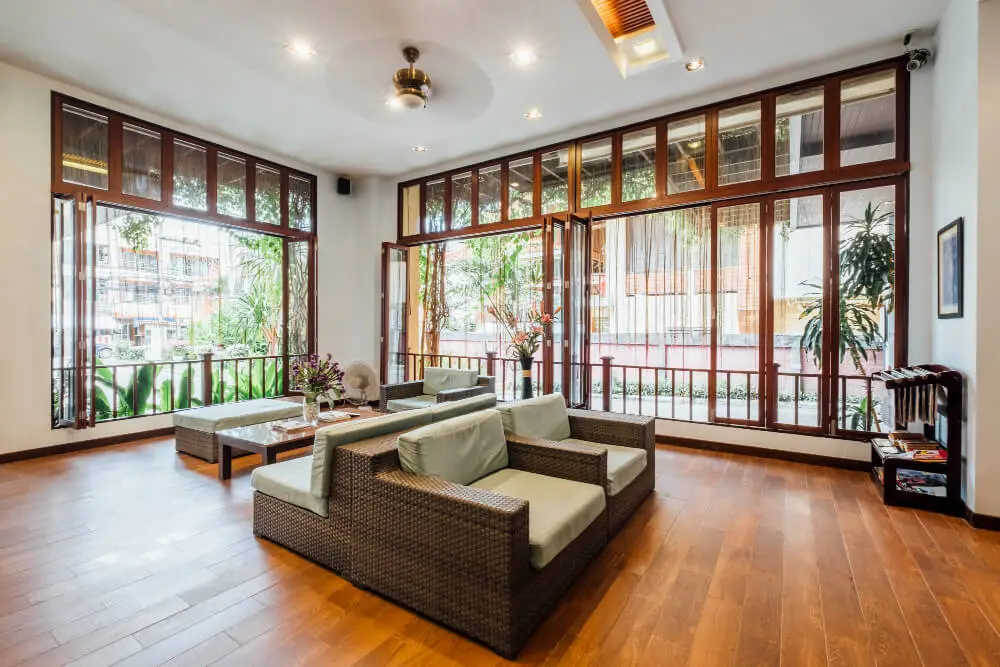A conservatory is a glass structure attached to a house, often used as a greenhouse or sunroom. An extension enlarges a house’s existing rooms.
When it comes to expanding your living space, you may find yourself torn between two popular options: a conservatory or an extension. Both offer unique advantages and considerations to take into account. So, which one is better? Are they really that different? Let’s dive into the key differences between conservatories and extensions to help you make an informed decision.
Key Takeaways
- Understanding the differences between a conservatory and an extension is crucial when considering expanding your living space.
- A conservatory is a glass structure attached to the side of a home, while an extension uses similar materials as the existing building to create a seamless appearance.
- Conservatories are generally more affordable and quicker to build, but may be more expensive to heat and provide less natural light than expected.
- Extensions offer more living space and can be designed for specific purposes, but are typically more expensive and require planning permission.
- The choice between a conservatory and an extension depends on your preferences, budget, and intended use of the space.
Now, let’s explore the construction, costs, planning permission, and benefits of conservatories and extensions to shed light on which option may be the best fit for you.
Construction and Design

The main distinction between a conservatory and an extension lies in their construction and design.
A conservatory is typically a glass structure attached to the side of a home, featuring a glass or polycarbonate roof. It creates a light and airy space that can be used for various purposes such as a dining room, kitchen, or home office.
An extension is constructed using similar materials as the existing building to create a seamless appearance, including solid walls and roof. It can be used to expand the living areas, adding extra bedrooms or extending the kitchen.
Cost Comparison
When thinking about getting a conservatory or an extension, one big thing to think about is how much it’ll cost. Conservatories usually cost less than extensions. That’s because they’re simpler to build and use cheaper materials like glass. Plus, they take less time to put up, so workers don’t charge as much.
Extensions, though, can be pricier. They need more stuff like architects’ fees and extra materials. Since they match your house, they cost more to make. So, if you’re on a tight budget, a conservatory might be the better choice. But if you want something that blends in perfectly with your house, an extension might be worth the extra money.
To illustrate the cost comparison between conservatories and extensions, here is a table highlighting some average price ranges:
| Construction | Average Cost Range |
|---|---|
| Conservatory | $10,000 – $30,000 |
| Extension | $20,000 – $100,000+ |
Please note that these are just average cost ranges, and the actual cost may vary depending on specific factors such as the size, design complexity, and the choice of materials.
It’s also important to consider the long-term financial implications of your choice. While a conservatory may be more affordable upfront, an extension can potentially add more value to your home, resulting in a higher return on investment in the future. Furthermore, extensions often provide more versatile space, which can further enhance the value and functionality of your property.
Planning Permission
When considering a conservatory or extension for your home, it’s important to understand the planning permission requirements. Whether or not planning permission is needed depends on the specific project and its compliance with permitted development rights.
Conservatory Planning Permission
In many cases, conservatories are considered permitted developments and do not require planning permission. However, there are certain limits and conditions that must be met.
- The conservatory must not exceed 50% of the total area of the property.
- It must not extend beyond the rear wall of the original house by more than 4 meters for a detached house, or 3 meters for a semi-detached or terraced house.
- The conservatory must not be higher than the highest part of the existing roof.
- No balconies, verandas, or raised platforms are allowed.
If your conservatory exceeds these limits, planning approval may be required, and it would be considered an extension.
Extension Planning Permission

Traditional extensions generally require planning permission, and it’s essential to check with the local authorities for specific requirements.
- The size, design, and location of the extension will determine whether planning permission is needed.
- Generally, if the extension is more substantial or alters the appearance of the property significantly, planning permission is required.
Permitted Development Rights
Permitted development rights may be applicable in some cases, allowing certain types of developments without the need for planning permission.
| Permitted Development Rights | Conservatory | Extension |
|---|---|---|
| Size Limit | Maximum of 50% of the total area of the property. | Varies depending on the location and nature of the extension. |
| Location | Usually at the rear of the property. | Varies depending on the property and local regulations. |
| Alterations | Must not involve significant changes to the appearance of the property. | May require planning permission if it alters the appearance significantly. |
It’s important to note that planning permission regulations may change, and it’s always recommended to consult with local planning authorities and seek professional advice before undertaking any construction project.
Benefits of Conservatories
Choosing a conservatory for your home comes with several advantages that make it an appealing option. Here are some key benefits of adding a conservatory:
- Easier installation: Compared to traditional extensions, conservatories are relatively easier and quicker to install. The construction process is cleaner, resulting in less disruption to your daily life.
- Additional living space: Conservatories provide you with valuable extra space in your home. Whether you need a new dining area, a home office, or a cozy lounge, a conservatory can be customized to suit your specific needs.
- Natural light: With their vast glass walls and roofs, conservatories allow abundant natural light to flood in. This not only creates a bright and inviting atmosphere but also helps reduce the need for artificial lighting during the day.
- Energy cost savings: The ample natural light that conservatories offer can help reduce your energy consumption. By harnessing the sun’s warmth, conservatories can contribute to heating your home naturally, leading to potential energy cost savings.
- Customization options: Conservatories can be tailor-made to match your personal preferences and complement the architectural style of your home. You can choose from various design options, including different types of glass, colors, and finishes, to create a unique and aesthetically pleasing space.
Overall, conservatories provide a cost-effective way to enhance your living environment, increase the value of your property, and enjoy the beauty of your surroundings from the comfort of your home.
Disadvantages of Conservatories
While conservatories offer several advantages, it’s important to consider their potential drawbacks before making a decision. Here are some key disadvantages of conservatories to keep in mind:
- Higher Heating Costs: Depending on the style and size of the conservatory, it may be more expensive to heat compared to traditional extensions. The large amount of glass and minimal insulation can result in heat loss, requiring additional heating to maintain comfortable temperatures.
- Reduced Natural Light: Despite the perception of conservatories as light-filled spaces, the presence of solid roofs and walls can limit the amount of natural light that enters the room. This can impact the overall brightness and ambiance of the space.
- Limited Functionality: While conservatories can serve as versatile living spaces, certain purposes such as a bathroom may not be suitable due to concerns related to privacy and ventilation. It’s important to carefully consider the intended use of the space and assess its suitability.
- Maintenance Requirements: Regular cleaning and upkeep are essential to prevent damage from moisture, pests, and other environmental factors. This includes cleaning the glass, checking for leaks, and addressing any issues promptly to ensure the longevity of the conservatory.
Although conservatories have their limitations, they can still be a valuable addition to your home if the advantages align with your needs and preferences. Now, let’s take a closer look at the benefits of extensions in the next section.
| Conservatory Disadvantages | Drawbacks of Conservatories |
|---|---|
| Higher heating costs | Reduced natural light |
| Limited functionality | Maintenance requirements |
Benefits of Extensions
Extensions are a popular choice for homeowners who want to add more space to their homes. They offer the flexibility to create extra bedrooms, a bigger kitchen, or even a home office, tailored to your needs. One of the best things about extensions is that they seamlessly blend in with your existing home’s architecture, making it look cohesive and increasing its value. While they can be a bit pricey compared to conservatories, extensions are a solid investment because they not only give you more room to relax and entertain but also boost the market value of your property.
However, before diving into an extension project, it’s essential to consider the costs and planning involved. Extensions typically require more money and time to build than conservatories because of extra expenses like architectural fees and longer labor hours. Plus, you might need to get permission from your local authorities depending on the size and location of your extension. Despite these factors, the benefits of extensions, including more space, custom design, and increased property value, make them a popular choice for homeowners looking to expand their living space significantly.
Disadvantages of Extensions
While extensions offer a number of benefits, it’s important to consider their potential drawbacks before making a decision. Here are some disadvantages to keep in mind:
- Higher Cost: Extensions can be more expensive to build compared to conservatories. In addition to the construction costs, you may also need to pay for additional architectural fees and longer labor hours.
- Disruption: The construction process of an extension can be disruptive to your daily life, especially if you plan to live in the property during the build. There may be noise, dust, and limited access to certain areas of your home.
- Planning Permission: Depending on the dimensions and location of your extension, you may be required to obtain planning permission from your local authorities. This can add extra time and effort to the project.
- Limited Light and Ventilation: Extensions with solid roofs and walls may result in reduced natural light and ventilation in the existing rooms adjacent to the extension. This should be taken into consideration when planning the design of your extension.
Despite these disadvantages, extensions can still be a great option for expanding your living space and adding value to your home. It’s important to weigh the pros and cons and consider your specific needs and circumstances before making a final decision.
Integrating Conservatories with Your Home
One advantage of a conservatory is the ability to seamlessly integrate it with your home. By incorporating specific design elements, you can achieve a cohesive and harmonious transition between your conservatory and the rest of your house. Here are some key features that facilitate integrating conservatories with your home:
Privacy Panels
Add privacy panels to the sides of your conservatory to shield it from prying eyes and create a secluded space within your property. These panels can be made from materials that match or complement the existing exterior of your home, ensuring a seamless visual appearance.
Full-Height and Dwarf Walls
Introduce full-height or dwarf walls to your conservatory design to enhance its structural integrity and create a more substantial feel. Choose a brick finish for these walls to blend with the brickwork of your house, further integrating the conservatory with your home’s overall aesthetic.
Modern Sliding Doors or Bi-fold Doors
Install modern sliding doors or bi-fold doors as the entrance to your conservatory. These contemporary door options not only provide easy access but also allow for a seamless flow between your indoor and outdoor spaces. When opened, they create a wide opening, visually merging the conservatory with your home’s surrounding environment.
Solar Control Glass Roof
A solar control glass roof not only allows natural light to flood into your conservatory but also helps regulate the temperature, preventing excessive heat buildup during hot summer months. This feature ensures optimal insulation and energy efficiency while creating a bright and inviting atmosphere.
By integrating these design elements, you can enhance privacy, insulation, ventilation, and natural light in your conservatory, while maintaining a consistent and harmonious appearance with the rest of your home’s architecture.
| Design Element | Benefits |
|---|---|
| Privacy Panels | – Shields conservatory from view – Creates a secluded space – Enhances privacy |
| Full-Height and Dwarf Walls | – Adds structural integrity – Creates a substantial feel – Blends with existing brickwork |
| Modern Sliding Doors or Bi-fold Doors | – Facilitates seamless indoor-outdoor flow – Provides easy access – Merges conservatory with surrounding environment |
| Solar Control Glass Roof | – Allows ample natural light – Regulates temperature – Enhances insulation and energy efficiency |
Rules and Regulations
When it comes to adding a conservatory or extension to your home, there are specific rules and regulations you need to follow to ensure compliance with planning permission requirements. The size and location of the structure play a crucial role in determining whether you can proceed without obtaining planning permission. It’s important to be aware of the conservatory planning permission rules and extension planning permission rules that apply in your area.
Conservatory Planning Permission Rules
Conservatories are often considered permitted developments, meaning they can be built without planning permission as long as they meet certain conditions and limitations. Some common rules for conservatories include:
- A single-storey rear conservatory can extend up to eight meters for detached houses.
- A single-storey rear conservatory can extend up to six meters for terraced or semi-detached properties.
- The conservatory must not exceed 50% of the total area of your property.
- The conservatory must not be higher than the highest point of the existing roof.
Extension Planning Permission Rules
Unlike conservatories, traditional extensions generally require planning permission before construction can begin. The specific rules and regulations for extensions can vary depending on the local planning authorities. It’s essential to consult with them to understand the extension planning permission rules that apply in your area. This will help you ensure compliance with the necessary regulations and avoid any potential issues down the line.
| Conservatory Planning Permission Rules | Extension Planning Permission Rules |
|---|---|
| A single-storey rear conservatory can extend up to 8 meters for detached houses | Traditional extensions typically require planning permission |
| A single-storey rear conservatory can extend up to 6 meters for terraced or semi-detached properties | Specific rules and regulations vary depending on local planning authorities |
| Conservatory must not exceed 50% of the total area of the property | Consultation with local planning authorities is essential |
| Conservatory must not be higher than the highest point of the existing roof |
Build Times and Foundations
The build times for conservatories and extensions can vary depending on several factors, including the size, style, weather conditions, and the experience of the installer. Generally, conservatories have shorter build times compared to extensions.
Conservatory Build Times
- Conservatories typically have shorter construction periods due to their simpler design and use of glass materials.
- The build time for a conservatory can range from a few weeks to a few months, depending on the complexity and size of the project.
- Factors such as the weather conditions and the efficiency of the installation team can also impact the build time.
Extension Build Times
- Extensions generally have longer build times compared to conservatories due to their more complex construction, including solid walls and roofs.
- The build time for an extension can vary significantly depending on factors such as the size, complexity, and specific requirements of the project.
- In most cases, the construction of an extension can take several months, and it may involve additional stages such as architectural planning and obtaining building permits.
Both conservatories and extensions require proper foundations to ensure the durability and stability of the structure.
Conservatory Foundations
- Conservatories typically require lighter foundations compared to extensions due to their lighter weight and construction materials.
- The foundations for a conservatory usually involve excavation, the installation of concrete footings, and the use of appropriate drainage systems.
Extension Foundations
- Extensions require more robust foundations compared to conservatories due to their heavier weight and the load-bearing requirements of the added space.
- The type of foundation for an extension will depend on factors such as the existing soil conditions, the size of the extension, and the type of construction materials used.
- Common types of foundations for extensions include strip foundations, piled foundations, and raft foundations.
The choice of materials, such as uPVC, aluminum, timber, and glazing options, can also impact the build times and overall stability of both conservatories and extensions.
Conclusion
Deciding between a conservatory and an extension depends on what you like, how much you can spend, and what you want to do with the space. Conservatories are simpler and cheaper, giving you more natural light and design options. They’re great if you want to expand your space without spending too much. Extensions offer more room and can be customized for specific needs like extra bedrooms or a bigger kitchen. But they cost more and take longer to build, sometimes needing permission first. Think about what you want, your budget, and how you want your home to look. Whether you pick a conservatory or an extension, both can add value and make your home better.
FAQ
What is the difference between a conservatory and an extension?
A conservatory is a glass structure attached to a home, while an extension is constructed using similar materials as the existing building, including solid walls and roof.
How much do conservatories and extensions cost?
Conservatories are generally more affordable due to their simpler construction and use of glass materials. Extensions can be more expensive due to additional architectural fees and longer labor hours.
Do I need planning permission for a conservatory or an extension?
Conservatories often fall under permitted development rights, while extensions typically require planning permission. Specific requirements should be checked with local authorities.
What are the benefits of a conservatory?
Conservatories are easier to install, provide additional living space and natural light, can be custom-made, and usually do not require planning permission if they meet certain conditions.
Are there any drawbacks to having a conservatory?
Depending on the style and size, conservatories may be more expensive to heat, provide less natural light than expected, and may not be suitable for all purposes.
What are the benefits of an extension?
Extensions provide more living space, can be designed for various purposes, increase property value, and improve functionality and flow.
What are the disadvantages of having an extension?
Extensions can be more expensive to build, may require planning permission, and can potentially reduce natural light and ventilation in existing rooms.
How can I integrate a conservatory with my home?
Privacy panels, full-height and dwarf walls, sliding or bi-fold doors, and a solar control glass roof can enhance privacy, insulation, ventilation, and natural light in the conservatory space.
Are there specific rules and regulations for adding a conservatory or extension?
The size and location of the structure determine permitted development rights. It’s essential to check with local planning authorities for the latest regulations and requirements.
How long does it take to build a conservatory or an extension?
Build times can vary based on factors such as size, style, weather conditions, and installer’s experience. Conservatories generally have shorter build times compared to extensions.
How do I choose between a conservatory and an extension?
The decision depends on preferences, budget, and intended use. Conservatories offer a simpler and more affordable option with additional natural light, while extensions provide more living space but involve higher costs and longer construction times.
Source Links
- https://www.conservatoryland.com/blog/conservatory-vs-extension/
- https://brackenwood.com/the-differences-between-extensions-conservatories-and-orangeries/
- https://www.orangeries-uk.co.uk/conservatory-vs-extension-which-one-is-the-better-option.html
Image Credits
Featured Image By – evening_tao on Freepik
Image 1 By – jcomp on Freepik
Image 2 By – jcomp on Freepik








